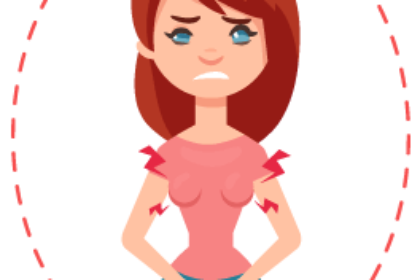BREAST LUMB, BREAST CYST, FIBROCYSTIC BREASTS, BREAST PAIN

Breast lumb, breast cyst, fibrocystic breasts, breast pain
These diseases are accompanied with knots in the breasts and dyscomfort symptoms in one or the other breast, and sometimes dyscomfort symptoms may even progress to pain. These are relatively frequent lesions, mainly benign. Fibrocystic change of the breasts is the most common, and it affects almost 60% of women, mainly between 30-50 years of age. Symptoms may be in a wide range in severity. They will usually regress after menopause.
Fibrocystic breasts can be painless, or cause only minimal tenderness. Symptoms often occur only in the time before period. Solitary nodules are mostly not palpable in this case, however, there are women who have intense pain in both breasts, and these are full with smaller or larger nodules. The picture may be extremely variable, but will usually affects both breasts symmetrically. It is mainly a disorder in women over 30 years of age. Hormonal alterations summing up over the years, and the subsequently changed breast structure will lead to this condition. The disorder affects the breast glands whose physiological function is to provide milk production after delivery. Glands are embedded in the fatty tissue of the breast.
The most important cause in the background of fibrocystic breast disease is the irregularity of hormonal changes, the hormonal imbalance. The most important female hormones are estrogen and progesterone, which lead to the growth and development of breast glands. Furthermore, some other hormonal changes also contribute to fibrocystic breast disorder. These hormones include prolactin, growth hormone, and thyroid hormones. In addition, hormone-like substances are also produced in the breast tissue, which play a role in the regulation of breast gland funcion, and their dysfunction may also contribute to the development of fibrocystic breast structure. Furthermore, their relation to hormones is very complicated. The function is therefore quite complex, and various immune cells will also join that to clear up unnecessary remnants of cyclic cell changes.
If the egg cell is not fertilized, and there is no neuroedocrine effect inducing milk production after delivery, the secretion produced in the breast gland in minimal amount will mostly be absorbed without any trouble during the normal cycle. In fibrocystic breasts, this absorption may be disturbed by various reasons resulting in the accumulation of the secretion within the glands formin smaller or larger cysts, and breast cysts will develop. As a result of hormones the amount of secretion will increase leading to the development of larger, palpable and tender cysts.
In the treatment of cystic breast disorders, the therapy should always be chosen according to the individual condition:
- Decreasing painful symptoms: by wearing the adeqate sized bra, even at night, and non steroid antiinflammatory pain killers (containing aspirin, ibuprofen and naproxen) may also be administered.
- Some vitamin supplements may also be beneficial, such as vitamins C, E, B6 and A.
- Many women reported the beneficial effect of treating the breast with primrose oil.
- Following adequate hormone system evaluation, an individual treatment strategy should be set up to treat hormonal changes. The treatment should be complex, including restoring possible changes of female hormones and, if needed, thyroid hormones, adrenal function and metabolism.
IN EVERY CASE COMPLETE HORMONAL EVALUATION IS REQUIRED AND CAUSES OF THE DISORDER SHOULD BE TREATED!
Prior to applied therapy, determination of progesterone/estrogen rate and, depending on the result, further gynecological and endocrinological hormone evaluation is elemental. The time point of hormone evaluation depends on the cycle of the given person, and it will never be determined based on the reference range seen on the laboratory report, whether a hormone normal or abnormal is, we always have to look at their proportion and the influence upon each other.
You may receive information about these methods and application possibilities in person – based on previous appointment (+36 70/23 89 689).






